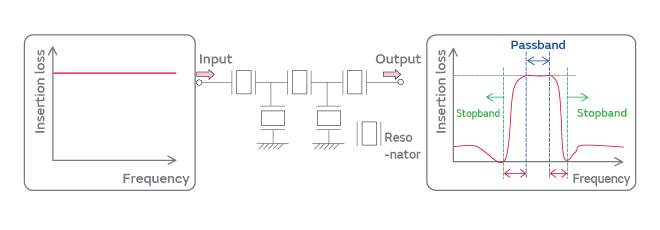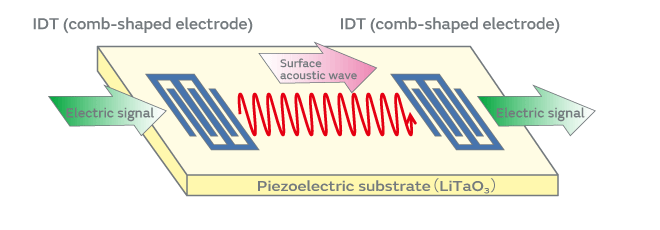Communications terminals are equipped with radio frequency filters, or RF filters, which process signals over a range of 800 MHz to 2500 MHz. Filters using a surface acoustic wave, or SAW, which propagates along the surface of a piezoelectric substrate, have been thus far widely used in these RF filters, but in recent years, following the increasing commercial application of a bulk acoustic wave, or BAW, the application of filters using BAW to the highly difficult bands that traditional SAW filters cannot deal with has increased.
Murata has developed Incredible High Performance-SAW filters, or I.H.P. SAW filters, which have overcome the shortcomings of traditional SAW filters, and successfully accomplished characteristics superior to BAW filters. In this article, we introduce the technologies used in the I.H.P. SAW filters.
1. Present State of RF Filters and Challenges in SAW Filters
RF filters are used in the transmitter and receiver circuit, or transceiver circuit, of communications terminals. They are devices that allow the passage of signals of desired frequency bands and block the passage of other unwanted ones. They are composed of more than one resonator: In general, a desired filter bandwidth is tailored by ladder circuits that are composed of resonators connected like a ladder (Fig. 1) . Bands available for communications terminals include those with various frequencies and passband bandwidths. The designs of the circuits and resonators in the terminals are optimized to comply with the standards of each allocated band.

What is important in the RF filters is steepness of the transition band, which is the curve connecting the passband and the stopband in the filter bandpass characteristics. The RF filters of which bandwidth between the passband and the stopband, or their transition bandwidth (as indicated by red arrows in Fig. 1) , is narrow are hard to design; filter characteristics with steeper transition bands are necessary. To increase the steepness of the transition band, the circuit design of the resonators composing the filters is certainly important; but the characteristics of the resonators themselves (quality factor, or Q factor) are also very important. To cater to the demand for the filter design for these highly difficult bands, various makers have been working to improve the Q factor of the resonators.
SAW devices based on monocrystalline piezoelectric LiTaO3 substrates have been widely used in RF filters. The filters have interdigital transducers, or IDTs, which are comb-shaped electrodes, mounted on the surface of a piezoelectric substrate. The resonance characteristics of the surface acoustic wave excited by the IDT are responsible for the characteristic band of the RF filter (Fig. 2).

There is a competing RF filter technology against SAW, which uses a bulk acoustic wave, or BAW. Common BAW filters have a piezoelectric substrate sandwiched between two electrodes and use thickness expansion vibration. The BAW filters, although characterized by the complexity in the manufacturing process and their high production cost, can accomplish higher Q characteristics than the SAW filters. The resonance characteristics of BAW allow us to construct RF filters that can achieve superior filter characteristics with a higher steepness. There are some technological challenges in terms of heat dissipation in the SAW filters; hence, the BAW filters have dominated the market of products for the highly difficult bands.
In this kind of environment, Murata has successfully developed the I.H.P. SAW filters, which have overcome the shortcomings of traditional SAW filters. The I.H.P. SAW filters provide a higher additional value; that is, while the products can offer filter characteristics equivalent or superior to the BAW filters, they possess temperature characteristics superior to the BAW filters: They have an advantage of higher heat dissipation.








